AEG W 1230 User Manual
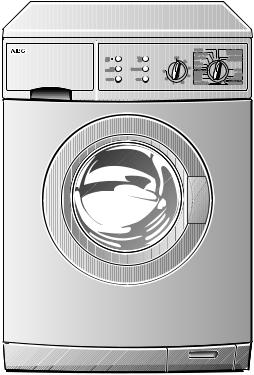
LAVAMAT W 1230
Washing Machine
User information

Dear Customer,
Please read this user information carefully.
Pay particular attention to the section "Safety" on the first Info pages. Please keep this user information in a safe place for later reference. Pass it on to any future owners of the unit.
1 The warning triangle and /or signal words (Warning!, Caution!, Important!) emphasise information which is important for your safety or for the unit's functional reliability. It is imperative that this information is observed.
01. This symbol guides you step by step through the operation of the appliance.
|
2. ... |
3 |
Next to this symbol you will find additional information and practical |
|
tips on using the appliance. |
2 |
Tips and information on economical and environmentally responsible |
|
use of the unit are identified with the clover leaf. |
For any faults which occur, this user information contains information on how to remedy these faults yourself. See the section "What to do if ..."
Printed on recycled paper.
Thinking ecologically means acting ecologically.
2

|
Contents |
CONTENTS |
|
Operating Instructions . . . . . . . . . . . . . . . . . . . . . . . . . . . . . . . . . |
. . . 6 |
Safety . . . . . . . . . . . . . . . . . . . . . . . . . . . . . . . . . . . . . . . . . . . . . . . . . . . . . |
. . . 6 |
Disposal . . . . . . . . . . . . . . . . . . . . . . . . . . . . . . . . . . . . . . . . . . . . . . . . . . . |
. . . 8 |
Environmental tips . . . . . . . . . . . . . . . . . . . . . . . . . . . . . . . . . . . . . . . . . . |
. . . 9 |
Unit description . . . . . . . . . . . . . . . . . . . . . . . . . . . . . . . . . . . . . . . . . . . . |
. . . 10 |
Front view . . . . . . . . . . . . . . . . . . . . . . . . . . . . . . . . . . . . . . . . . . . . . . . . . |
. . . 10 |
Drawer for Washing Powder and Care Agent . . . . . . . . . . . . . . . . . . . . |
. . . 10 |
Control Panel . . . . . . . . . . . . . . . . . . . . . . . . . . . . . . . . . . . . . . . . . . . . . . |
. . . 11 |
Programme Knob . . . . . . . . . . . . . . . . . . . . . . . . . . . . . . . . . . . . . . . . . . . . |
. . . 11 |
Temperature Selector . . . . . . . . . . . . . . . . . . . . . . . . . . . . . . . . . . . . . . . . |
. . . 13 |
Additional Programme Buttons . . . . . . . . . . . . . . . . . . . . . . . . . . . . . . . . |
. . . 13 |
ON/OFF button . . . . . . . . . . . . . . . . . . . . . . . . . . . . . . . . . . . . . . . . . . . . . . |
. . . 14 |
Consumption values and time requirements . . . . . . . . . . . . . . . . . . . |
. . . 15 |
Before the First Wash . . . . . . . . . . . . . . . . . . . . . . . . . . . . . . . . . . . . . . . |
. . . 16 |
Prepare washing cycle . . . . . . . . . . . . . . . . . . . . . . . . . . . . . . . . . . . . . . . |
. . . 16 |
Sort washing and prepare . . . . . . . . . . . . . . . . . . . . . . . . . . . . . . . . . . . . . |
. . . 16 |
Washing Types and Care Symbols . . . . . . . . . . . . . . . . . . . . . . . . . . . . . . |
. . . 17 |
Washing Detergents and Care Agents . . . . . . . . . . . . . . . . . . . . . . . . . . . |
. . . 18 |
Which detergent and care agent? . . . . . . . . . . . . . . . . . . . . . . . . . . . |
. . . 18 |
How much detergent and care agent? . . . . . . . . . . . . . . . . . . . . . . . |
. . . 18 |
Water Softener . . . . . . . . . . . . . . . . . . . . . . . . . . . . . . . . . . . . . . . . . . . . . . |
. . . 18 |
Running a Wash Cycle . . . . . . . . . . . . . . . . . . . . . . . . . . . . . . . . . . . . . . |
. . . 19 |
Brief Instructions . . . . . . . . . . . . . . . . . . . . . . . . . . . . . . . . . . . . . . . . . . . . |
. . . 19 |
Add the washing . . . . . . . . . . . . . . . . . . . . . . . . . . . . . . . . . . . . . . . . . . . . |
. . . 20 |
Add Washing Detergent and/Care Agent . . . . . . . . . . . . . . . . . . . . . . . . |
. . . 21 |
Setting the Wash Programme . . . . . . . . . . . . . . . . . . . . . . . . . . . . . . . . . |
. . . 22 |
Changing the Spin Speed/Selecting Rinse Hold . . . . . . . . . . . . . . . . . . . |
. . . 23 |
Start the Wash Programme . . . . . . . . . . . . . . . . . . . . . . . . . . . . . . . . . . . |
. . . 23 |
Wash Programme Progress . . . . . . . . . . . . . . . . . . . . . . . . . . . . . . . . . . . . |
. . . 24 |
Changing/Interrupting the Wash Programme . . . . . . . . . . . . . . . . . . . . |
. . . 24 |
Wash Cycle Completed/Removing Washing . . . . . . . . . . . . . . . . . . . . . . |
. . . 25 |
3

Contents
Programme Tables . . . . . . . . . . . . . . . . . . . . . . . . . . . . . . . . . . . . . . . . . . . . . |
26 |
|
Washing . . . . . . . |
. . . . . . . . . . . . . . . . . . . . . . . . . . . . . . . . . . . . . . . . . . . . . . . |
26 |
Separate Rinse . |
. . . . . . . . . . . . . . . . . . . . . . . . . . . . . . . . . . . . . . . . . . . . . . . |
27 |
Separate Conditioning/Starching/Finishing . . . . . . . . . . . . . . . . . . . . . . . . |
27 |
|
Separate Spin . . |
. . . . . . . . . . . . . . . . . . . . . . . . . . . . . . . . . . . . . . . . . . . . . . . |
27 |
Cleaning and Care . . . . . . . . . . . . . . . . . . . . . . . . . . . . . . . . . . . . . . . . . . . . . |
28 |
|
Control panel . . . . |
. . . . . . . . . . . . . . . . . . . . . . . . . . . . . . . . . . . . . . . . . . . . . . |
28 |
Detergent Drawer |
. . . . . . . . . . . . . . . . . . . . . . . . . . . . . . . . . . . . . . . . . . . . . . |
28 |
Washing Drum . . . |
. . . . . . . . . . . . . . . . . . . . . . . . . . . . . . . . . . . . . . . . . . . . . . |
29 |
Main door . . . . . . . |
. . . . . . . . . . . . . . . . . . . . . . . . . . . . . . . . . . . . . . . . . . . . . . |
29 |
What to do if ... |
. . . . . . . . . . . . . . . . . . . . . . . . . . . . . . . . . . . . . . . . . . . . . . . |
30 |
Remedying Faults . |
. . . . . . . . . . . . . . . . . . . . . . . . . . . . . . . . . . . . . . . . . . . . . . |
30 |
If the washing results are not satisfactory . . . . . . . . . . . . . . . . . . . . . . . . . . |
33 |
|
Carrying out emergency drainage . . . . . . . . . . . . . . . . . . . . . . . . . . . . . . . . . |
34 |
|
Drain pump . . . . . . |
. . . . . . . . . . . . . . . . . . . . . . . . . . . . . . . . . . . . . . . . . . . . . . |
35 |
Child Safety Feature . . . . . . . . . . . . . . . . . . . . . . . . . . . . . . . . . . . . . . . . . . . |
37 |
|
Installation and connection instructions . . . . . . . . . . . . . . . . |
38 |
Installation Safety Precautions . . . . . . . . . . . . . . . . . . . . . . . . . . . . . . . . . . |
38 |
Installation of the appliance . . . . . . . . . . . . . . . . . . . . . . . . . . . . . . . . . . . . |
39 |
Transporting the appliance . . . . . . . . . . . . . . . . . . . . . . . . . . . . . . . . . . . . . . . |
39 |
Remove transport packaging . . . . . . . . . . . . . . . . . . . . . . . . . . . . . . . . . . . . . |
39 |
Prepare the installation place . . . . . . . . . . . . . . . . . . . . . . . . . . . . . . . . . . . . |
41 |
Installation on a concrete base . . . . . . . . . . . . . . . . . . . . . . . . . . . . . . . . |
41 |
Installation on vibrating floors . . . . . . . . . . . . . . . . . . . . . . . . . . . . . . . . . |
41 |
Compensate for floor unevenness . . . . . . . . . . . . . . . . . . . . . . . . . . . . . . . . . |
42 |
4

|
Contents |
Electrical connection . . . . . . . . . . . . . . . . . . . . . . . . . . . . . . . . . . . . . . . . |
. . . 43 |
Water connection . . . . . . . . . . . . . . . . . . . . . . . . . . . . . . . . . . . . . . . . . . |
. . . 43 |
Permissible water pressure . . . . . . . . . . . . . . . . . . . . . . . . . . . . . . . . . . . . |
. . . 43 |
Water inflow . . . . . . . . . . . . . . . . . . . . . . . . . . . . . . . . . . . . . . . . . . . . . . . |
. . . 44 |
Water drain . . . . . . . . . . . . . . . . . . . . . . . . . . . . . . . . . . . . . . . . . . . . . . . . |
. . . 45 |
Delivery heads over 1m . . . . . . . . . . . . . . . . . . . . . . . . . . . . . . . . . . . . . . . |
. . . 45 |
Technical data . . . . . . . . . . . . . . . . . . . . . . . . . . . . . . . . . . . . . . . . . . . . . |
. . . 46 |
Dimensions . . . . . . . . . . . . . . . . . . . . . . . . . . . . . . . . . . . . . . . . . . . . . . . |
. . . 46 |
Warranty conditions / Customer service centres . . . . |
. . . 47 |
Index . . . . . . . . . . . . . . . . . . . . . . . . . . . . . . . . . . . . . . . . . . . . . . . . . . . . . |
. . . 50 |
Service . . . . . . . . . . . . . . . . . . . . . . . . . . . . . . . . . . . . . . . . . . . . . . . . . . . |
. . . 51 |
5

Operating Instructions
Operating Instructions
1 Safety
The safety aspects of AEG electrical appliances comply with accepted technical standards and the German Appliance Safety Law. However, as manufacturers we regard it as our responsibility to inform you about the following safety instructions.
Before Using for the First Time
•Refer to the "Installation and Connection Instructions" further on in this user information.
•If units are delivered in the winter months at minus temperatures: Store the washing machine at room temperature for a few hours before putting it into operation.
Correct Use
•The washing machine is only intended for washing normal domestic washing. If the appliance is used for a wrong purpose or wrongly operated, the manufacturer cannot assume any liability for any damages.
•Additions or modifications to the washing machine are strictly forbidden due to safety reasons.
•Use only detergent which is suitable for washing machines. Refer to the detergent manufacturer's instructions.
•The washing must not contain any flammable solvents. Also bear this in mind when washing pre-cleaned washing.
•Do not use the washing machine for dry-cleaning.
•Dyes /dye-removing agents may only be used in the washing machine if the manufacturer expressly permits use of these products. We cannot accept liability for any damage.
•Use only water from the water mains. Use rain water or service water only if it meets the requirements defined in DIN 1986 and DIN 1988.
•Frost damage is not covered by the warranty! If the washing machine is in a room subject to possible frost hazards, emergency emptying must be carried out if there is a risk of frost (see the Section "Carrying out emergency emptying“).
6

Operating Instructions
Safety of Children and Infirm Persons
•Packaging materials (e.g. films, polystyrene) can be dangerous for children. Risk of suffocation! Keep packaging away from children.
•The appliance is not intendet for use by young children or infirm persons without supervision.
•Children frequently cannot recognise hazards involved in handling electrical appliances. Therefore, ensure that they are properly supervised during operation and never allow children to play with the washing machine -there is a risk that they can lock themselves inside it.
•Ensure that children or small animals do not climb into the washing machine's drum.
•When disposing of washing machines pull out the mains plug, destroy the door lock, cut off the electrical supply lead and dispose of the plug and remaining cable. This means that playing children cannot shut themselves in and cannot encounter a potentially lethal hazard.
General Safety
•Repairs to the washing machine may only be carried out by qualified specialists. Incorrect repairs may result in significant risk to the user. If repairs are necessary, consult our customer service or your specialist dealer.
•Never use the washing machine if the mains cable is damaged or the conrol panel, work surface or base panel area are so badly damaged that the interior of the unit is openly accessible.
•Switch off the washing machine before carrying out cleaning, care and maintenance work. Also pull the mains plug out of the socket or,
– if it is permanently connected, – switch off the circuit breaker at the household power distribution box or completely remove the screw-in fuse.
•If operation is stopped, disconnect the appliance from the mains supply and shut off the tap.
•Never pull the cable to remove the plug from the socket. Always pull the plug itself.
•Multiple connectors, couplings and extension cables must not be used. There is a risk of fire with overheating!
•Do not spray down the washing machine with a water jet. Risk of electric shock!
7

Operating Instructions
•The glass in the door becomes hot in the case of wash programmes with high temperatures. Do not touch!
•Allow the washing solution to cool before carrying out an emergency emptying operation or cleaning the drain pump.
•Small animals can chew the power cables and water hoses. Risk of electric shock and danger of water damage! Keep small animals away from the washing machine.
2 Disposal
Disposing of the Packaging Material!
Dispose of the packaging of your washing machine correctly. All pakkaging materials used are environmentally-compatible and recyclable.
• Plastic parts are identified with internationally standardised abbreviations:
>PE<
>PS<
>POM<
•Cardboard packaging is manufactured from recycled paper and should be deposited in the waste paper collection for recycling.
Disposing of your old appliance!
When you put your unit out of operation one day, please bring it to your nearest recycling centre or to your dealer.
8

Operating Instructions
2Environmental tips
•A pre-wash cycle is not necessary in the case of washing which is not excessively dirt. This saves detergent, water and time (and is gentle on the environment.)
•If the indicated load capacities are taken full advantage of, the washing machine is especially efficient.
•For small loads, use only one half to one third of the recommended detergent quantity.
•Suitable pre-treatment enables marks and limited amounts of dirt to be removed. You can then wash at a lower temperature.
•Wash slightly to normally dirty cottons with the energy-saving program.
•There is often no need for the softener. Try it once! If you use a drier, your washing will become soft and fluffy even without a softener.
•In the case of medium to high water hardness (hardness range runs to upwards, see "Detergent and care agents“), you should use a water softener. The detergent can then always be metered for hardness range I (= soft).
9
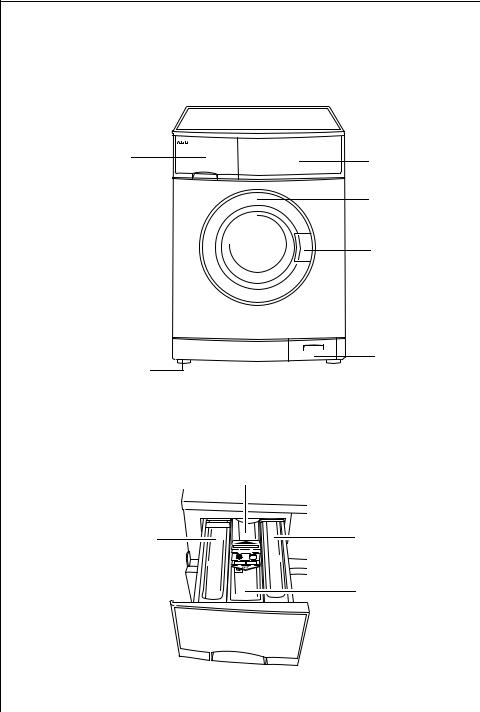
Operating Instructions
Unit description
Front view
Drawer for de- |
|
|
tergent and |
Control panel |
|
care agent |
||
|
||
|
Rating plate (be- |
|
|
hind filling door) |
|
|
Main door |
Screw feet |
Flap in front of |
|
drain pump |
||
(height-adjustable) |
||
|
Drawer for Washing Powder and Care Agent
|
In-wash stain treatment |
|
Main detergent |
Pre-wash detergent/ |
|
(powder) and water- |
||
soaking agent |
||
softener if required |
||
|
||
|
Liquid care agent |
|
|
(conditioner, finisher, |
|
|
starch) |
10
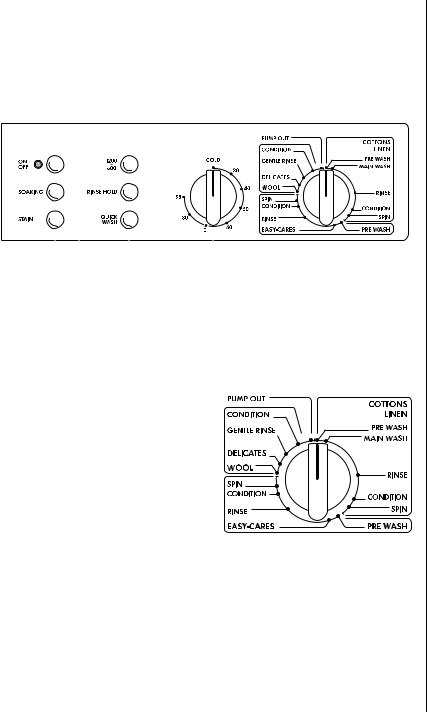
|
|
|
|
|
|
|
|
Operating Instructions |
||
Control Panel |
|
|
|
|
|
|
|
|
|
|
|
Spin speed button |
|
Program selector |
|||||||
ON/OFF |
|
RINSE HOLD button |
|
|
|
|
||||
|
|
|
|
|
||||||
button with power in- |
|
|
|
|
|
|||||
dicator light |
|
|
|
|
|
|
|
|
|
|
|
|
|
|
|
|
|
|
|
||
|
|
|
|
|
|
|
|
|
|
|
|
|
|
|
|
|
|
|
|
|
|
|
|
|
|
|
|
|
|
|
|
|
|
|
|
|
|
|
|
|
|
|
|
|
|
|
|
|
|
|
|
|
|
|
|
|
|
|
|
|
|
|
|
|
|
|
|
|
|
|
|
|
|
|
|
|
|
|
|
|
|
|
|
STAIN button |
QUICK WASH |
Temperature |
|||
|
|
button |
selector |
||
|
|
|
|
|
|
SOAKING button
Programme Knob
The programme knob determines the type of wash cycle (eg. water level, drum movement, number of rinses, spin speed) according to the type of the articles to be washed.
Important! Only turn the programme knob in a clockwise direction!
Programme group COTTONS/LINEN
PRE WASH
Pre wash for cottons/linen (approx. 30 minutes, temperature limited to a maximum of 40 °C). The main wash follows immediately afterwards.
MAIN WASH
Main wash cycle for cottons/linen (cold up to 95 °C).
11

Operating Instructions
|
RINSE |
|
Separate rinse followed by spin or rinse hold, eg. for rinsing hand- |
|
washed cottons/linen. |
3 |
Rinse hold means: The washing remains lying in the last rinsing water. It |
|
is not spun. |
CONDITION
Separate conditioning, separate starching or separate finishing for damp cottons/linen (1 rinse, liquid care agent is flushed in from the compartment æ followed by spin or rinse hold).
SPIN
Spin after rinse hold or separate spin for handwashed cottons/linen.
Programme group EASY-CARES
PRE WASH
Pre wash for easy-care textiles (approx. 30 minutes, temperature limited to a maximum of 40 °C). The main wash cycle follows automatically.
EASY-CARES
Main wash cycle for easy-care textiles (cold to 60 °C).
RINSE
Separate rinse followed by spin or rinse hold, eg. for rinsing handwashed easy-care articles.
CONDITION
Separate conditioning, separate starching or separate finishing for damp easy-care textiless (1 rinse, liquid care agent is flushed in from the compartment æ followed by spin or rinse hold).
SPIN
Spin after rinse hold or separate spin for handwashed easy-care articles, woollens and delicates.
Programme group WOOL/DELCATES
WOOL
Main wash cycle for machine washable woollens and particularly delicate textiless (cold to 40 °C).
DELICATES
Main wash cycle for delicates (cold to 40 °C).
12
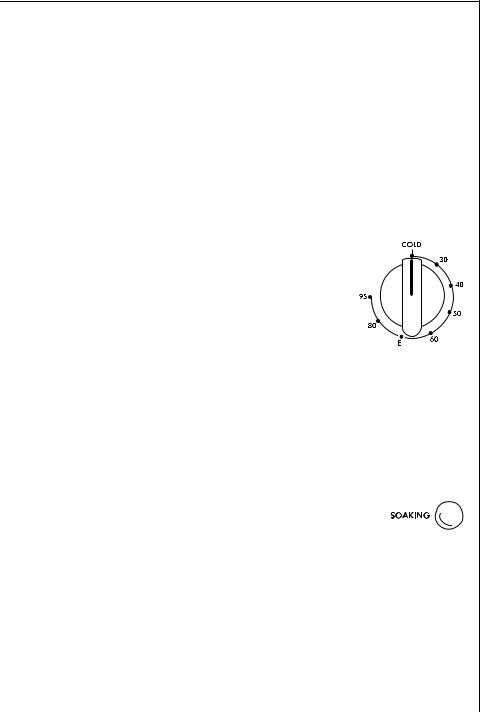
Operating Instructions
GENTLE RINSE
Separate gentle rinse followed by short spin or rinse hold, eg. for rinsing hand-washed woollens or delicates.
CONDITION
Separate gentle conditioning for damp woollens or delicates (1 gentle rinse, liquid care agent is washed in from the compartment æfollowed by short spin or rinse hold).
PUMP OUT
Water pumped out without spin, eg. after rinse hold.
Temperature Selector
|
The following settings are possible: |
|
COLD, 30, 40, 50, 60, E, 80, 95 °C. |
2 |
Position E (Energy-saving programme) |
|
Instead of a wash cycle at 95 °C the en- |
ergy-saving programme at approx. 70 °C can be used for lightly or normally soiled cottons.
Additional Programme Buttons
|
The additional programme buttons are for suiting the wash programme |
|
to the dirtiness of the washing. Additional programmes are not re- |
|
quired for washing which is not excessively dirty. |
3 |
The additional programmes can only be used in conjunction with pro- |
|
grammes for the programme groups COTTONS/LINEN and EASY-CARES. |
SOAKING
Soaking time approx. 35 minutes; Temperature limited to a maximum of 40 °C.
SOAKING can be used in conjunction with programme knob settings:
– PRE WASH COTTONS/LINEN;
– PRE WASH EASY-CARES.
At the end of the soaking programme the washing will remain in the washing solution until you release the SOAKING button by pressing again. The main wash cycle for COTTONS/LINEN or EASY-CARES will follow.
13
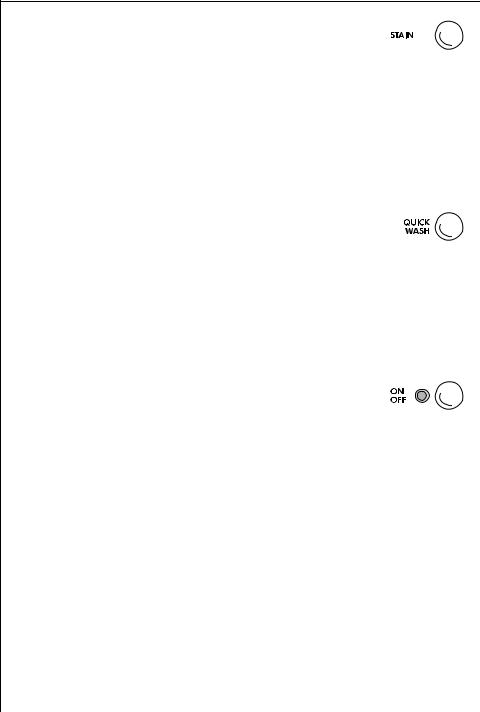
Operating Instructions
STAIN
For dealing with heavily soiled or stained washing (in-wash stain treatment is added at the optimum time during the course of the programme).
STAIN can be used in conjunction with the programme knob settings:
–PRE WASH COTTONS/LINEN;
–MAIN WASH;
–PRE WASH EASY-CARES;
–EASY-CARES.
QUICK WASH
Shorter washing cycle for lightly soiled washing.
QUICK WASH can be used in conjunction with the programme knob settings:
–MAIN WASH;
–EASY-CARES.
ON/OFF button
Pressing the ON/OFF button switches the washing machine on and starts the selected programme. Pressing the button again switches the washing machine off.
14

Operating Instructions
Consumption values and time requirements
The values for selected programmes in the following tables were determined under standardized conditions. They are nonetheless a useful guide for domestic use.
|
Temperature |
Filling |
Water |
Energy |
Time in |
|
Programme knob |
quantity |
|||||
selector |
in litres |
in kWh |
minutes |
|||
|
in kg |
|||||
|
|
|
|
|
||
MAIN WASH |
95 |
5 |
57 |
1.90 |
140 |
|
MAIN WASH |
601) |
5 |
54 |
0.95 |
128 |
|
MAIN WASH |
40 |
5 |
54 |
0.60 |
115 |
|
EASY-CARES |
40 |
2.5 |
45 |
0.40 |
65 |
|
DELICATES |
30 |
2.5 |
40 |
0.25 |
40 |
|
WOOL |
30 |
2 |
43 |
0.25 |
50 |
|
|
|
|
|
|
|
1)Information: Programme setting for a test in accordance with EN 60 456. The consumption values can deviate from the stated values depending on the water pressure, hardness, inlet temperature, room temperature, type and quantity of washing, the detergent powder/liquid used, fluctuations in the mains voltage and selected additional functions.
15

Operating Instructions
Before the First Wash
01. Pull the washing powder drawer out slightly.
2.Pour about 1 litre of water through the washing powder drawer into the washing machine. The next time a programme is started the solution container will be closed and the eco-sluice can function correctly.
3.Run one wash cycle without washing:
–Programme knob on position MAIN WASH;
–Temperature 95 °C;
–Only add half the quantity of detergent recommended by the manu-
facturer for a full load.
This removes residues left over from manufacture on the drum and solution container.
Prepare washing cycle
Sort washing and prepare
•Sort the washing according to the care symbol and type (see "Washing types and care codes").
•Empty all pockets.
•Remove metal objects (paper clips, safety pins etc.).
•To prevent damage to the washing and tangled washing: Close zip fasteners, button bed and pillow covers closed, tie up loose strings e.g. of aprons.
•Turn articles with double layered textiles inside out (sleeping bags, anoraks etc.).
•In the case of knitted coloured textiles and also with wool and textiles with jewelry attached: turn inside out.
•Wash small and sensitive items (e.g. baby socks, tights and stockings, bras etc.) in a washing net, a cushion with a zip fastener or in larger socks.
•Handle curtains with particular care. Metal rollers or burred, plastic rollers must be removed or tied into a net or bag. We cannot accept liability for damage.
•Coloureds and white items must not be washed together in a washing cycle. This could discolour white washing or turn it grey.
•There is often excess dye in new, coloured items. It is best to wash such items separately the first time.
16
